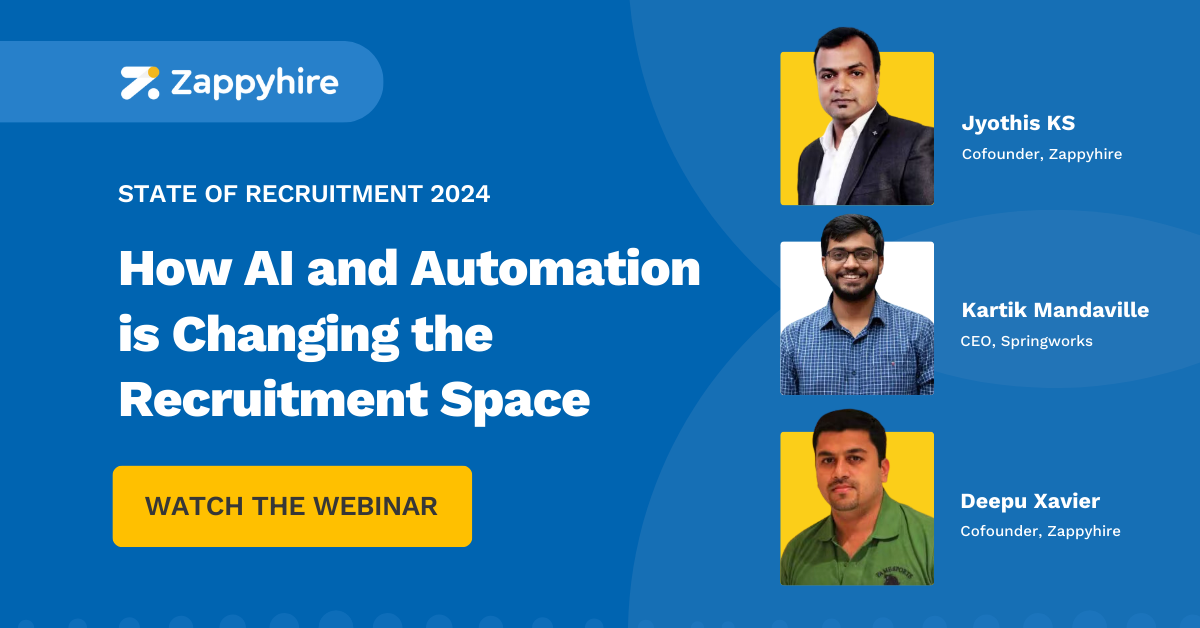
Are you familiar with the struggle of extended hiring periods, missing out on top candidates, and the costliness of recruitment?
These are just a few among the countless hurdles known to recruiters in every industry. While their magnitude might differ across sectors, the bottom line remains the same— recruitment is a challenging endeavour.
Now, if we were to shift focus to the healthcare industry, projected to add about 2.1 million jobs in the next 10 years (45% of all new jobs), the recruitment challenges here are vastly distinct from those faced in other industries.
However, the impact, the magnitude of these challenges, vary significantly. Imagine a healthcare facility grappling with a shortage of essential professionals?
That’s surely a looming disaster waiting to happen!
Recruitment in healthcare isn’t just about filling roles; it’s about safeguarding the backbone of institutions, ensuring their ability to deliver critical services during critical times.
The unique challenges in healthcare recruitment demand innovative solutions and strategies that go well beyond conventional recruitment strategies.
In this blog, we’ll explore the most critical healthcare recruitment challenges, and their impact, and, most importantly, equip HR professionals like you with the solutions needed to tackle these challenges head-on.
From scarcity in skilled professionals to the nuances of retention tactics, are you geared up to take a close look at the varied complexities specific to healthcare recruitment?

TABLE OF CONTENTS 1. What is healthcare recruitment? 2. The current state of healthcare recruitment 3. 8 major healthcare recruitment challenges and their solutions 4. How Zappyhire recruitment automation software’s advanced tools revolutionized recruitment for a leading hospital
What is healthcare recruitment?
As mentioned above, the requirements for hiring significantly varies from industry to industry. Different industries call for specific professionals possessing industry-specific skills, experiences, qualifications, and unique qualities tailored to that particular field.
Healthcare recruitment is one such example of this tailored hiring process wherein the primary focus is on identifying, attracting, and selecting professionals with the right skills and qualities required to thrive within healthcare institutions.
The entire process of recruitment in the healthcare industry is aimed at securing individuals who possess the necessary technical know-how.
In addition to this, they must also possess certain traits such as empathy and dedication to patient care.

The current state of healthcare recruitment
Like most industries when it comes to recruitment, the world of healthcare recruitment remains dynamic, constantly grappling with the latest and newest developments.
It’s no surprise that recruiters in this field find themselves struggling to keep pace with the ever-evolving landscape.
47% of HR teams face an uphill battle when it comes to sourcing suitable talent, while an additional 16% of teams deal with higher-than-usual turnover rates.
The factors that contribute to this talent scarcity include a considerable aging population among both patients and healthcare professionals, countless instances of employee burnout.
Additionally, the limited availability of residency slots for medical school graduates, is also a potential factor that contributes to the countless challenges faced in healthcare recruitment.
Interestingly (but not surprisingly), the retention of existing employees tops the priority list for healthcare institutions, with 68% of HR teams flagging it as a major concern.
Moreover, in recent times, as a response to the shortage of talent in this industry, many healthcare organizations (35%) are now turning to contingent workers (a workforce hired for a specific purpose, for a fixed period of time, on a temporary/ contractual basis).
The aim is to bridge the gaps in their workforce to meet and manage the requirements of the escalating patient volumes.
This industry’s expansion, accounting for about 45% of all new jobs, further underscores the increasing demand for healthcare services and the corresponding need for a robust workforce.
Furthermore, it also lays emphasis on the critical need for innovative recruitment strategies to navigate these complexities and ensure a sustainable healthcare workforce.

8 major healthcare recruitment challenges and their solutions
- Shortage of skilled professionals:
The shortage of skilled professionals is an alarming challenge, especially in an industry like healthcare where expertise literally becomes a matter of life and death.
A recent survey conducted revealed that a major concern among clinicians is a global healthcare workforce shortage, with 74% predicting there will be a shortage of nurses and 68% predicting a shortage of doctors in 10 years’ time.
Concerning, to say the least!
The root cause of this challenge originates from a growing demand for specialized roles amidst an inadequate supply.
It ultimately results in a strain on existing staff, increased workloads, and eventual burnout, directly affecting patient care quality.
Additionally, prolonged vacancies and higher hiring costs further compound the issue.
In order to tackle this, organizations can try shifting their focus towards implementing competitive compensation and workforce development programs.
Furthermore, strategic collaborations with educational institutions, and formulating clear pathways for career advancement in order to attract and retain skilled talent should be considered.
- Competition for top professionals:
Considering the scarcity of talent in the industry, it’s no surprise there’s cutthroat competition for the limited existing talent.

The fact that top talent stays in the market only for an average of 10 days, further exacerbates this challenge.
Losing top talent owing to the fierce competition that exists in the industry, impacts not just organizational performance, but team dynamics as well.
This in turn, significantly affects the quality of services provided to patients.
This challenge also results in prolonged recruitment processes (a vicious cycle in its own right) and increased costs.
Employers are now responding to this by strengthening their employer brand, offering attractive EVPs, creating conducive work environments, and implementing robust referral programs to secure and retain top talent.
- Lack of diversity hiring strategies:
Diversity hiring is a common challenge across all industries but is a crucial one to tackle at the earliest stages.
The absence of diverse hiring practices limits perspectives and innovation in healthcare.
It leads to reduced employee morale, hampers creativity, and affects patient care quality due to limited viewpoints.
Implementing diversity hiring strategies such as mandatory diversity training, fostering an inclusive workplace culture, and forming diverse hiring panels are crucial steps to create a more diverse and inclusive healthcare workforce.
As a testament to the above, close to 92% of business leaders agree that a strategic workforce education program should help an organization achieve its diversity and inclusion goals.
- Competency and skills gap:
Recruiters, even if you manage to scoop up existing talent, it’s futile if the quality of hire is poor, i.e., they lack the necessary skills and qualities to thrive in the industry.
In a recent study conducted, it was found that a significant proportion of active health workers in India were not qualified enough to work in the healthcare industry.
Additionally, it was also reported that more than 20% of qualified health professionals are not active in labor markets.
The competency and skills gap among healthcare professionals poses a serious threat to service quality, patient care and their overall well-being.
Incompetencies lead to inefficiencies, thereby affecting the overall efficiency of the team.
Irresponsibly hiring underqualified healthcare professionals can be life-threatening in certain cases, which is why hiring skilled and qualified healthcare professionals should be a top priority.
Addressing this gap involves conducting thorough skills assessments and tailored training programs.
Providing opportunities to upskill, and implementing mentorship initiatives to bridge the competency divide among healthcare staff is imperative.
- High attrition rates:
Now, let’s say you do manage to find good talent, high attrition rates render recruitment efforts futile (again).
High turnover rates in healthcare institutions interfere with existing workflows, further increase recruitment costs, and can potentially decrease team morale, impacting patient care continuity.
A 2023 Gartner survey reported that employees who feel engaged and excited about their jobs are 31 % more likely to continue working at an organization.
Improving engagement strategies, conducting meaningful exit interviews (and acting upon the inferences made during them), and enhancing workplace satisfaction are integral steps to reduce attrition rates in healthcare organizations.
It’s all about understanding employee needs and striking the right balance.
- Time-consuming hiring operations:
Time is precious and time is money, especially in hiring operations, where inefficiencies can cost both time and money.
Lengthy hiring processes hinder operational efficiency, delay patient care, increase recruitment costs, and affect staffing needs.
Time-consuming hiring operations increase the cost per hire, delay productivity, and affect service delivery timelines.
Streamlining operations through highly advanced Talent Acquisition suites like Zappyhire, implementing data-driven strategies, collaborative hiring methods, and hiring contingent workers, can reduce these challenges pertaining to high time-to-hire.
- Budgetary constraints:
Did you know, a report by Deloitte revealed that staffing alone can represent up to a whopping 70% of a hospital’s cost?
Financial constraints are a major challenge in recruitment, affecting resource allocation and strategies.
While it is understandable that the healthcare industry is an expensive one, limited budgets impact recruitment strategies, resource allocation, and access to critical tools and quality recruitment channels.
This constraint leads to inefficient recruitment processes and compromises the quality of hires.
Cost-effective hiring strategies, strategic resource allocation, and negotiations for partnerships are crucial in effectively overcoming these constraints in healthcare recruitment.
- High number of hard-to-fill (HTF) roles:
Identifying hard-to-fill roles is one thing, but the consequences of having many of them are equally impactful.
Managing many hard-to-fill roles strains healthcare organizations, as the time-to-hire in these instances is relatively higher, which in turn impacts the smooth operation of the institute.
The impact isn’t limited to just that. It can negatively affect the quality of patient care provided, increase workload on existing staff (which could result in instances of burnout), and decrease team morale.
Through targeted recruitment approaches, competitive compensation packages, a compelling EVP, and incentives and benefits, it may be possible to fill these hard-to-fill roles quickly and effectively.

How Zappyhire recruitment automation software’s advanced tools revolutionized recruitment for a leading hospital
60 nurses. 160 applicants. 36 hours. That’s the Zappyhire effect.
A leading hospital in Kerala faced an urgent requirement to fill crucial positions. Baby Memorial Hospital (BMH), operating at full capacity, needed a rapid and efficient solution.
Zappyhire stepped in, leveraging its highly advanced tools to transform BMH’s recruitment landscape.
With an overwhelming response of 160 applicants, BMH needed to swiftly select and recruit 60 nurses. Zappyhire’s innovative tools, renowned for their efficiency, agility, and precision, orchestrated a remarkable feat.
In just 36 hours, Zappyhire facilitated the selection and recruitment of these 60 nurses, ensuring the hospital continued its critical operations seamlessly.
The Chief Operating Officer at BMH acknowledged the software’s profound effect, and had the following to say about Zappyhire-
“We were able to handle 150% of the usual recruitment workload with the same hiring resources, gaining 100% visibility into the process and metrics. It was a real blessing during the current healthcare crisis situation.”
Saji Mathew (Chief Operating Officer, Baby Memorial Hospital)
To delve deeper into this transformative experience, we invite you to explore a detailed case study, unveiling how Zappyhire’s cutting-edge tools reshaped BMH’s recruitment operations.

Recruitment in the healthcare realm isn’t a walk in the park; each hurdle adds more weight to an already critical process.
Healthcare institutions need to pinpoint these challenges’ root causes and formulate and implement smart, cost-effective solutions.
If your organization faces similar challenges, prompt action is crucial. Take the initiative and book a demo with us.
Let’s join hands to resolve these recruitment challenges together and build you a highly skilled and effective workforce, equipped to cope with any challenge that may come their way!






